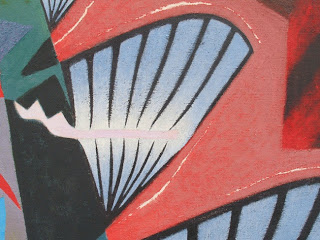 |
| Tom Holdman, Stained Glass Artist and 'Roots of Knowledge' |
Illuminating Knowledge: Creating a Major Stained Glass Installation to Foster Engaged Learning at Utah Valley University is the first Artisan Lecture this fall at The General Society of Mechanics & Tradesmen of the City of New York, Monday, October 17th, 20 W. 44 St. Free Exhibition viewing, same day, from 11 am to 8:30 pm. Advance registration recommended, contribution, $10, to attend the 6:30 pm Panel Discussion and Reception. (Visit www.generalsociety.org for the other free exhibition visiting hours scheduled from October 12 to October 15.
 |
| ROOTS OF KNOWLEDGE Stained Glass Mural utilizes the symbolism of a tree's roots connecting humanity |
This Artisan lecture will be in a panel discussion format and the program will discuss the creation of "Roots of Knowledge," a significant new work of monumental proportion that will soon be installed in the Library at Utah Valley University (UVU) in Orem, Utah. The mural utilizes the symbolism of a tree and the roots that flow through the windows include leaves from part of the world a section is depicting, along with a DNA strand running through the roots and connecting humanity. Speaking at a Roots of Knowledge UVU meeting the artist said, "Our goal is to create the most inspiring piece of art glass ever created on this earth. I love the medium of glass, there is nothing else like that feeling, it just speaks."
Roots of Knowledge invites the public's interest. It is an interactive piece. People will be able to click on a picture of the window and get more information about why the artists on the project choose certain elements."
The program on the 17th will also touch upon the production of stained glass in New York City.
Roots of Knowledge: Conceived by Utah artist and former UVU student, Tom Holdman, and UVU President Matthew Holland, the work was commissioned to celebrate the 75th anniversary of what is today the largest public university in the state. In this program Mr. Holdman and President Holland will speak about the evolution and development as a fusion of art, education, and public spaces.
 |
| Tom Holdman and his mural at Utah Valley University |
TOM HOLDMAN: Owns and operates Holdman Studios, Inc., located at Thanksgiving Point in Lehi, Utah. His works of art appreciated worldwide and represent many different techniques in glass. In a field where competition can be steep, he has committed himself to producing visually stunning, emotionally moving and inspiring pieces of art that stand the test of time. His journey has included enhancing edifices of all types---private and public, sacred and secular.
Tom Holdman is a visionary. Along with the incredible designs that fill his mind are the endless possibilities of how to use those designs to enhance the life experiences of others. Bravo to Tom Holdman, a man who overcame a speech impediment to express his genius in "Speaking Through Glass," which incidentally is also the title of a video documentary created about Tom and aired on PBS.
Inquiries about this review may be addressed to pollytalknyc@gmail.com












